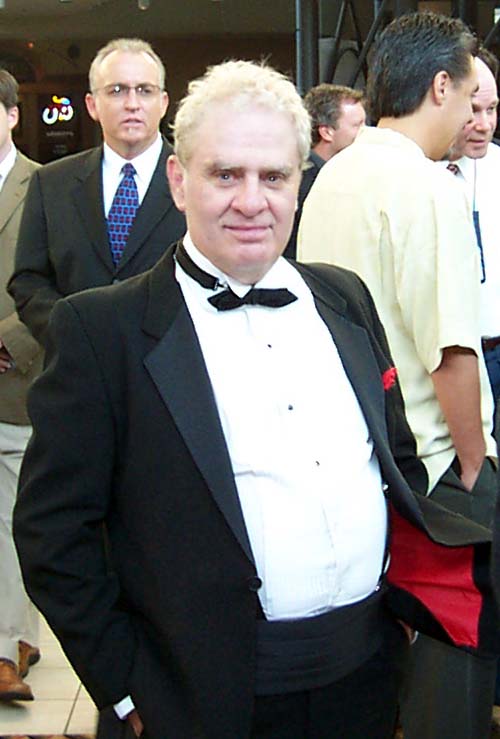The conference begins its second/final full day.
This morning dawned cold, as we experienced our first hard frost of the season. One disadvantage of being local to a game conference is having extra responsibilities, such as figuring out where you put the ice scraper in order to clear your windshield. Of course, the corresponding advantage is having appropriate winter clothing available without having to remember to pack it.
The morning keynote was Games that Move Us: Designing More Powerful Emotional and Social Play Experiences, presented by Katherine Isbister of the NYU Game Center (and more). This talk was quite interesting and informative, looking at the connection between physical actions and emotional states in the realm of games, where requiring certain activities or postures can have a real and measurable impact on the players.
Professor Isbister introduced the concept of the “physical feedback hypothesis”, wherein a human being has an innate emotional response to an imposed physical position. She first described it with the anecdotal story of a mother telling her child to stand up straight and adopt a confident posture, which in turn actually conveys an internal feeling of confidence. Then she described (and showed pictures) of a study that proved the facial feedback hypothesis by means of a special game controller that players had to hold in their mouths. Depending on the position of the controller, the participants mouths were “tricked” into either a simulated smile or frown, and those whose faces were made to smile were statistically more likely to report positive feelings, and to like the controller, than those who frowned.
This idea was then expanded into the concept of “emotional contagion“, where one person is (innately) influenced by the emotions of others. I know that we experience this here all the time, when one family member is in a bad mood and it seems to rub off on the rest of the family, even without direct negative interactions. (The next time this happens, I will to try to counter it with unbridled happiness, even if I have to fake it [a la the previous paragraph].) In the specific area of games, the mood of players simultaneously playing a game spread to each other and to non-players in the room. Adding the earlier concept to the equation, enticing the players to make happy/silly dance movements (for example) improve the mood and connection between players. This was demonstrated with video of players using We Cheer as well as a custom Wii game created specifically for a study (and involving the controllers inside silly hats).
Katherine Isbister mentioned, as an aside, that studies show a hunched posture, as our ancestors might have adopted as a defensive position, evokes a physical reaction (i.e., release of hormones) that actually increases stress and blood pressure, and she noted that this is not unlike the position we take when sitting at a desk working with a keyboard. Also, just because she mentioned it, here is a video of a cat using an iPad. Finally, the talk ended with a call to action for deeper discourse on this idea of the actual physiological effects that games can have on players and how to harness that to make more powerful (and positive) game experiences.
During the first set of breakout sessions for the day, I attended a roundtable, Video Game Violence: Is There a Role for it in Meaningful Play. This session dealt with both the title topic and the secondary issue of the upcoming Supreme Court case, which is particularly interesting to me, having testified before the Michigan Senate Judiciary Committee back in 2005 in opposition to a similar law restricting sales of video games. The discussion was very active and open, and the consensus seemed to be that video games have some effect on players, certainly, but that aspect still needs significant study yet, and in any case, legal restrictions on games are a bad idea. It is truly disappointing that politicians cannot be as thoughtful and deliberative as the people here.
I made the observation that I just wanted the law declared unconstitutional (again, once and for all) so we can then focus on the more subtle and important areas of academic research and understanding, without the threat of the blunt instrument of legislative policy interfering, for which I was later personally thanked by the primary moderator, Maria Chesley Fisk, Deputy Director of Health Games Research. The conversation among most of the roundtable participants continued well after the session was officially over, and I did not end up leaving the room until more than 40 minutes into the lunch break. This was a very valuable discussion.
Of course, a shortened lunch break (plus payroll) meant that I was late getting back to the conference for the next talk, Navigating the Wilderness of Educational Entertainment: Design Challenges in Man vs. Wild: The Game, presented by Nathanial McClure, Patrick Shaw, and Brian Winn. This session was fascinating because the development was a collaboration between Scientifically Proven Entertainment (with McClure and Shaw), F84 Games (in LA), and game development students at Michigan State University (under Brian Winn). The project also involved publisher Crave Entertainment and Discovery Channel. I was disappointed to have missed the beginning, since the logistics of this arrangement were apparently discussed before I was there, though hearing about the design challenges for the game (to be released in early 2011) was also interesting.
The final breakout sessions of the day had me attending a panel, Growing the Game Industry in Michigan: Two Years Later, which is (of course) directly relevant to our company. As the title suggests, this was a followup to a similar panel on the first day of Meaningful Play 2008. The lineup featured the return of Matt Toschlog (Reactor Zero), Gjon Camaj (Image Space), and Brian Winn (moderator), who were joined this time by “Than” McClure (from the previous session), Jared Riley (Hero Interactive), and Ken Droz (formerly of the Michigan Film Office). The discussion was mostly about the 42% tax credit for building games in Michigan, which enticed McClure to move his company to Michigan from Los Angeles; the elephant in the room was the fact that he is currently suing the state to actually receive the promised incentives, after his company was promoted as a “success story”. All members of the panel (even despite these issues) agreed that Michigan is a great place to live and do business.
The afternoon keynote, Finding the Feeling: Experimental Development @thatgamecompany, presented by Robin Hunicke, was ostensibly about design challenges in Journey, a game currently under development by thatgamecompany, but it was also an inspirational talk that reminded me why we create games and what they have to offer players. She spoke about the intellectual, emotional, and social needs of players, and she noted how much tone of voice and body language are involved in human-to-human connection, but is usually lost in game environments. She concluded that, “collaboration is hard”.
I was interested to hear that they create a “thesis” for the game, and that it was, essentially, too personal to share with the audience, although earlier theses, “Together we can move the mountain” and “We all walk the path; each journey is different“, were mentioned. Alas, I cannot properly convey the moving spirit of this presentation in a blog; suffice it to say that it was very good.
Immediately following the keynote was the MSU Ten Years of Games Happy Hour Gathering, which was a networking event at a local brew pub. I had a chance to talk with several people, including a lengthy conversation reminiscing about the game industry, and other topics, with Rod Myers, a PhD student at Indiana University. When Jared Riley gave his “keystone speech”, celebrating his company’s fourth anniversary, I realized how fortunate I am to still be in this industry (as one of the “old guys” at the conference).
Friday was a great day.




